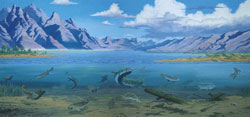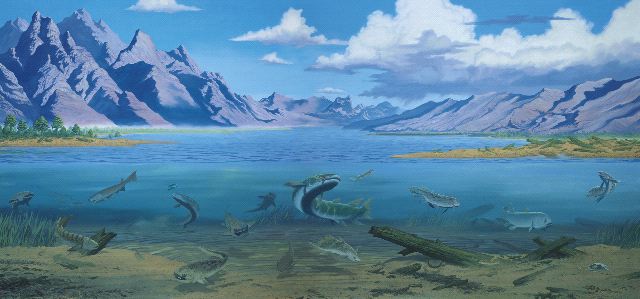The animals of Miguasha
Miguasha fauna is among the most representative of the Devonian Period. It is as if Miguasha is a window with an excellent view onto the world of vertebrates as they branched out during the “Age of Fishes”.
 (40 kb) Invertebrate animals in aquatic and terrestrial environments were also well represented as they underwent a similar diversification. It was a turning point for many animals in the history of evolution... a time when a number of them began to leave their watery realm and conquer land.
(40 kb) Invertebrate animals in aquatic and terrestrial environments were also well represented as they underwent a similar diversification. It was a turning point for many animals in the history of evolution... a time when a number of them began to leave their watery realm and conquer land.
Miguasha fauna includes about twenty essentially endemic fish species, meaning that they are not found in other regions of the globe. These species represented some of the key stages in vertebrate evolution, and they belonged to various groups, many of which are now extinct. Their forms included the most primitive and the most specialized fish in evolutionary history.
Countless animals commingled in the estuarian waters. From large carnivores with strong bodies and sharp teeth, to small bottom-feeding fish eking out their existence by filtering mud, to little spiny fish darting around the water in schools... this ecosystem held as many predators as it did prey!
At the base of the newly-formed Appalachians, this large estuary served as a link between the mountain rivers and the distant sea. The water was rather oxygen-poor, so lungs became the norm among many fish species. The oxygen that could not be obtained through gills could be drawn in with a few gulps of air. Some Miguasha species may also have adapted to survive out of the water for short periods of time, and even to crawl on the shore with the help of their strong fins before returning to the water.
As a community, Miguasha’s vertebrates and invertebrates, both aquatic and terrestrial, were an integral part of a long-vanished ecosystem that left behind enough detailed traces for us to reconstruct it with considerable accuracy.

 (40 kb) Invertebrate animals in aquatic and terrestrial environments were also well represented as they underwent a similar diversification. It was a turning point for many animals in the history of evolution... a time when a number of them began to leave their watery realm and conquer land.
(40 kb) Invertebrate animals in aquatic and terrestrial environments were also well represented as they underwent a similar diversification. It was a turning point for many animals in the history of evolution... a time when a number of them began to leave their watery realm and conquer land.Miguasha fauna includes about twenty essentially endemic fish species, meaning that they are not found in other regions of the globe. These species represented some of the key stages in vertebrate evolution, and they belonged to various groups, many of which are now extinct. Their forms included the most primitive and the most specialized fish in evolutionary history.
Countless animals commingled in the estuarian waters. From large carnivores with strong bodies and sharp teeth, to small bottom-feeding fish eking out their existence by filtering mud, to little spiny fish darting around the water in schools... this ecosystem held as many predators as it did prey!
At the base of the newly-formed Appalachians, this large estuary served as a link between the mountain rivers and the distant sea. The water was rather oxygen-poor, so lungs became the norm among many fish species. The oxygen that could not be obtained through gills could be drawn in with a few gulps of air. Some Miguasha species may also have adapted to survive out of the water for short periods of time, and even to crawl on the shore with the help of their strong fins before returning to the water.
As a community, Miguasha’s vertebrates and invertebrates, both aquatic and terrestrial, were an integral part of a long-vanished ecosystem that left behind enough detailed traces for us to reconstruct it with considerable accuracy.
Site map | Feedback | Links | Sources | Credits
The animals of Miguasha
<< Toward the first tetrapods | A window through time >>

Title: The Miguasha paleoestuary
Author: Illustration by François Miville-Deschênes
Sources: Parc national de Miguasha
Year: 2003
Description:
A fresco of the ancient Miguasha estuary with the peaks of the young Appalachian mountain range in the background. The fish fauna were diversified, but it was Eusthenopteron foordi that dominated this watery world. Vegetation was concentrated along the shore, dense and tall enough in places to make forests.


